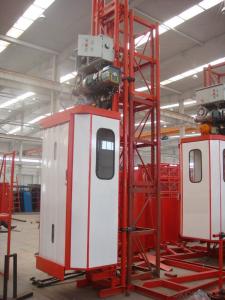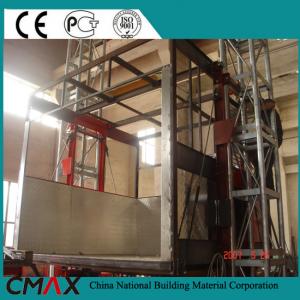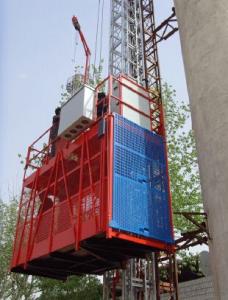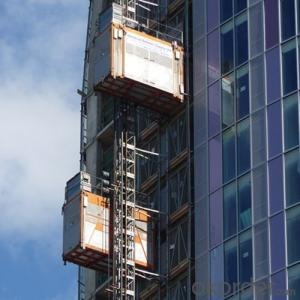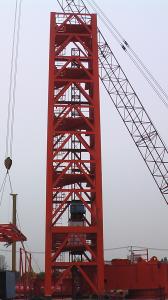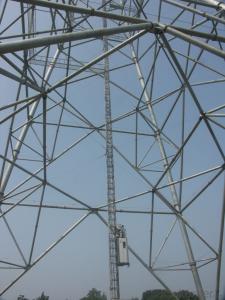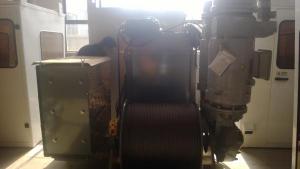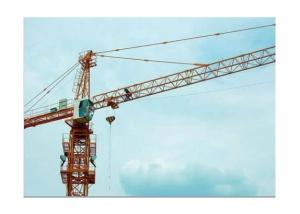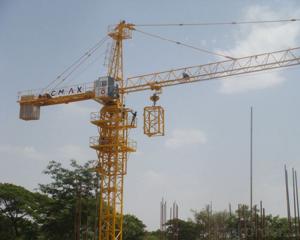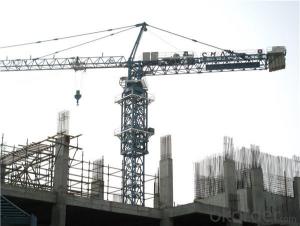Mini Hoist for Tower Crane
- Loading Port:
- Tianjin
- Payment Terms:
- TT or LC
- Min Order Qty:
- -
- Supply Capability:
- 40 units unit/month
OKorder Service Pledge
OKorder Financial Service
You Might Also Like
Mini hoist for tower crane installed outside
1, single cage
2, maximum capacity:200kg or 400kg
3, Middle speed:33m/min
4, Main part welded by robot
The mini building hoist is set up with fixed speed and single cage, used for the lifting of tower crane driver and some minor tools.
Every cage has one or two suits of independent driving mechanism. According to the size of tower crane mast sections, the
mini building hoist can be chosen to install inside or outside of the tower crane.
Driven by rack and pinion can speed up and slow down steadily. It has features such as:
1. Reduce the labour working intensity of tower crane driver, especially for the tower crane height upto 100m.
2. The lifting speed can be tailored if client prefers using frequency inverter.
We can provide tailored design, backing on the strong technical strength of China Academy of Building Research.
Building hoist:
1). Cage load capacity: 2, 000kg
2). Lifting speed: 36m/min, 0 - 63m/min, 0 - 96m/min
3). Mast section: Painted or hot dipped zinc
4). Cage: Single cage or twin cage
5). Recommended cage inner dimensions (L x W x H): 2.5 x1.3 x 2.5m, 3.0 x 1.3 x 2.5m, 3.2 x 1.5 x 2.5m, 3.6 x 1.5 x 2.5m, 3.8 x 1.5 x 2.5m, 4.0 x 1.5 x 2.5m, 4.2 x 1.5 x 2.5m, according to requirements of customers
6). Motor and reducing device: Made in China, or uses SEW according to requirements
7). Counterweight: With counterweight or without counterweight
8). Color of cage: Yellow, red, blue
9). Cage load capacity: 1, 200kg, 2, 000kg, 2, 700kg or 3, 200kg
We offer most kinds for building hoist, if you are interested, please feel free to contact me.
Construction lift with Interver:
| Characteristics | Model | Rated Loading | Lifting Speed | Motor Power | |
| Double Cabin | Low-speed | SC200/200D | 2 × 2000kg | 0-36m/min | 2 × (3 × 11kw) 2 × (2 × 13kw) 2 ×(2 × 15kw) |
| SC100/100D | 2 × 1000kg | 0-36m/min | 2 × (2 × 11kw) | ||
| Mid-speed | SC200/200Z | 2 × 2000kg | 0-60m/min | 2 × (3 × 15kw) | |
| SC100/100Z | 2 × 1000kg | 0-60m/min | 2 × (2 × 15kw) | ||
| Single Cabin | Low-speed | SC200D | 2000kg | 0-36m/min | 3 × 11kw 2× 13kw 2× 15kw |
| SC100D | 1000kg | 0-36m/min | 2 × 11kw | ||
| Mid-speed | SC200Z | 2000kg | 0-60m/min | 3× 15kw | |
| SC100Z | 1000kg | 0-60m/min | 2 × 15kw | ||
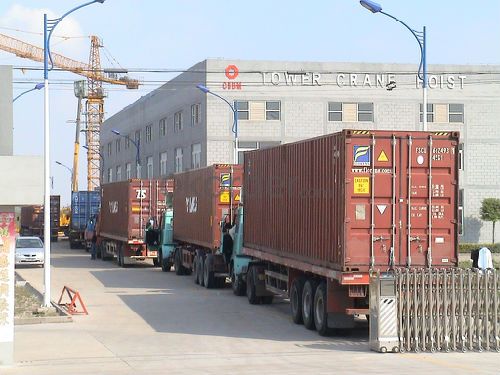

- Q: This question asks for a description of the process of using an electric motor in the context of a building hoist, which is a device used for lifting and lowering materials in construction.
- <p>To use an electric motor with a building hoist, first ensure the hoist is properly installed and secured. Connect the hoist to a power source and check that all safety features are operational. Turn on the motor and test the hoist's movement in both directions to confirm functionality. When lifting materials, ensure they are evenly distributed and securely attached to the hoist. Operate the motor to lift or lower the load, maintaining a steady speed and monitoring for any signs of strain or malfunction. Always follow the manufacturer's guidelines and safety precautions to prevent accidents.</p>
- Q: The construction elevator can not operate during the use of several stages of wind power
- Well, there are no definite rules. It's up to you to decide whether to use it or not
- Q: Is it possible to utilize a building hoist for the purposes of renovation projects?
- <p>Yes, a building hoist can be used for renovation work. These hoists are designed to lift and lower materials and personnel efficiently, making them ideal for construction and renovation projects. They help in moving heavy materials such as bricks, cement, and tools to different floors without the need for manual labor, thus increasing safety and productivity. However, it's crucial to ensure that the hoist is properly installed, maintained, and operated by trained personnel to avoid accidents and ensure the safety of all involved.</p>
- Q: Explain how a lifting platform, specifically a building hoist, operates.
- <p>A building hoist, also known as a construction hoist, is a temporary lifting platform used in construction to lift materials and personnel vertically within a building under construction. It operates by using a motor-driven pulley system that runs on guide rails or tracks. The hoist is attached to the building structure and as the building grows, the hoist is extended upwards. The platform is loaded with materials or workers, and the operator controls the ascent or descent through an electrical switch or remote control. Safety features include limit switches to prevent over-travel, safety catches to stop the platform in case of a cable failure, and interlocks to ensure the platform cannot be operated when the doors are open.</p>
- Q: How many people are there for construction workers
- The elevator is a vertical elevator with electric motors, which is equipped with box pods for multi-storey building and carrying goods. There is also a terrace, which is running continuously on the crawler, commonly known as escalator or automatic walkway. A fixed lifting device for the floor. Vertical elevator has a car, running on at least two columns of the vertical or Angle is less than 15 ° between the rigidity of rail. The size and structure of the car is convenient for passengers to enter or unload cargo. Traditionally, the elevator is the general term for vertical transportation in buildings, no matter how they are driven. Speed can be divided into low speed elevator (1 m/s), rapid elevator (1 ~ 2 m/s) and high speed elevator (2 m/s). Hydraulic elevators were introduced in the mid-19th century and are still being used in low-rise buildings. In 1852, the United States developed a safety elevator for wire rope lifting. In the 1980s, there was further improvement in drivers, such as the electric motors, which were driven by worm gears to turn the winding drum and balance weight. At the end of the 19th century, the friction wheel drive greatly increased the lift height.
- Q: Is it permissible to utilize electric or hydraulic building hoists in personal workshops or factories?
- <p>Yes, you can use an electric or hydraulic building hoist in your own workshop or factory. However, you must ensure that the hoist complies with local safety regulations and standards. It's crucial to have the hoist installed by qualified professionals and to maintain it regularly to prevent accidents. Always follow the manufacturer's guidelines and safety protocols to ensure the safe operation of the hoist.</p>
- Q: There are differences between the construction elevator and the construction elevator
- When it comes to the construction elevator, people will immediately think of construction lifter, the construction elevator and elevator is just a different name or have their own respective working principle? By below small make up to you to introduce: construction elevator is often referred to as construction lifter, but construction lifter, including the definition of a broader platform construction also belongs to the construction lifter series.
- Q: Is it possible to use two lifting devices simultaneously to lift an object that is heavier than the maximum weight each device can handle individually?
- <p>Yes, two lifting devices can be used together to lift a heavier object than either one can handle alone, provided that both devices are capable of supporting the combined weight and are properly synchronized. This requires careful planning and coordination to ensure the safety of the operation and the integrity of the lifting devices. The total weight capacity of the combined system should be greater than the weight of the object being lifted, and the devices must be designed to work in tandem without overloading or causing damage.</p>
- Q: What precautions should be taken when operating a building hoist to ensure safety?
- <p>Safety measures for using a building hoist include ensuring the hoist is regularly inspected and maintained, following the manufacturer's guidelines. Operators must be trained and certified. Load limits must be strictly adhered to, and the hoist should not be overloaded. A safety cage or gate should be in place to prevent accidental falls. Emergency stop switches should be easily accessible. Regular inspections for wear and tear, especially on cables and hooks, are crucial. Never use a hoist if it shows signs of damage or malfunction. Always secure loads properly to prevent them from shifting during transport.</p>
- Q: Is it feasible to utilize a building hoist for lifting heavy objects when the ground is not level?
- <p>A building hoist is generally designed for vertical lifting in a stable and level environment. Using it on uneven ground can be hazardous and is not recommended due to the risk of tipping or instability. For lifting heavy objects on uneven ground, it's advisable to use specialized equipment like mobile cranes or all-terrain forklifts that are designed to handle such conditions. Always consult the manufacturer's guidelines and safety regulations before using any lifting equipment.</p>
Send your message to us
Mini Hoist for Tower Crane
- Loading Port:
- Tianjin
- Payment Terms:
- TT or LC
- Min Order Qty:
- -
- Supply Capability:
- 40 units unit/month
OKorder Service Pledge
OKorder Financial Service
Similar products
Hot products
Hot Searches
Related keywords
